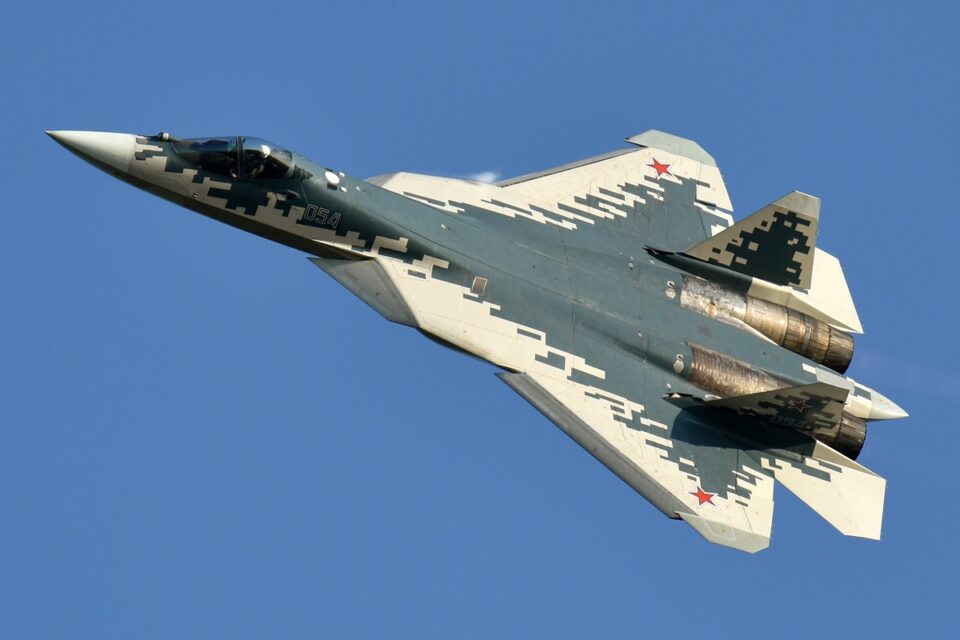Aviation
Russia may not produce more Su-57s, and production is now gradually being stopped for this reason

In a significant setback for Russia’s military ambitions, the country has suspended production of its advanced Su-57 Felon fighter jets.
This decision primarily stems from the impact of Western sanctions, which have severely restricted access to essential components needed for the aircraft’s production, as reported by The Telegraph.
Analysts from the Ukrainian research group Frontelligence Insight have emphasized the heavy reliance of Russia’s military industry on Western technology, particularly in electronics. They noted that sanctions have throttled the supply of critical hardware, jeopardizing the Su-57’s production.
Frontelligence Insight conducted an analysis of Russian documents, identifying key bottlenecks in the production process. Among these were the WA36 attenuator—an electronic device crucial for signal calibration—and various power supplies.
These components are integral to the MPPU-50, a German device essential for calibrating the Su-57’s communication system. The lack of these critical parts has forced Russian military leaders to reassess their plans for modernizing their air fleet.
As a result of these production challenges, the Russian military is considering shifting its focus to more economical fighter jets, such as the MiG-35. The potential revival of production for older aircraft models, despite their simplicity, may represent a symbolic victory for Russia’s adversaries.
The Su-57 program was originally intended to bring Russia’s capabilities in line with those of the U.S. Air Force. However, the situation is increasingly dire; by the time Russia fulfills its initial order of Su-57 jets, the U.S. Air Force is already advancing plans for a new stealth fighter to succeed the F-22.
First taking flight in 2010, the Su-57 has faced a tumultuous path. Over the past decade, Sukhoi has painstakingly hand-built ten test models. In 2019, the Kremlin signed a contract for 76 serial production jets at an estimated cost of $50 million each.
To date, Sukhoi has delivered the first ten serial models to the Russian Air Force in 2022, followed by eleven more in 2023, with only a few additional jets delivered in 2024.
Compounding the situation, Russia’s air force has already suffered losses, with two Su-57s—one test model and one serial production model—crashing in separate incidents. Additionally, a strike on the Akhtubinsk airfield in June destroyed at least one Su-57, further straining the program.
As the suspension of Su-57 production unfolds, the future of Russia’s military aviation capabilities remains uncertain, with the nation grappling with the repercussions of ongoing sanctions and the pressing need for modernization.

Aviation
COMAC Unveils Plans for the C929 to Rival Airbus and Boeing

After the success of China’s first C919 aircraft, the country is setting its sights on developing a larger plane. COMAC (Commercial Aircraft Corporation of China) has officially confirmed plans to build a widebody aircraft, marking a significant step in its aircraft lineup.
Traditionally, Airbus and Boeing dominate the widebody aircraft market, with decades of expertise in developing planes and engines capable of carrying heavy payloads. China, which currently relies on imported engines, is now aiming to challenge these giants with its own widebody jet, the C929, designed to compete with the Airbus A350 and Boeing 777.
American Airlines Is Looking for Flight Attendants: Apply Now
The C929 will be China’s first independently developed long-range widebody aircraft. It adheres to international airworthiness standards and boasts independent intellectual property rights. The baseline version is designed to seat 280 passengers and offers a range of 12,000 kilometers, catering to global demand for both regional and international air travel.
Russia, which also needs reliable narrowbody and widebody aircraft, could become a key customer for the C929. Additionally, China plans to target the broader Asian market as it continues to expand its aviation capabilities.
Close Call at Heathrow: BA Flight Narrowly Escapes Drone Collision
China’s aviation progress includes the ARJ21 (now called C909), a regional jet with 100 seats for shorter routes, and the C919, a narrowbody jet with 180 seats designed to rival the Boeing 737 MAX and Airbus A320. Both models have found increasing demand in the domestic market.
At China’s largest air show in Zhuhai, COMAC announced that Air China will be the launch customer for the C929 widebody jet, though details about order size and delivery timelines were not disclosed.
Other major deals announced by COMAC include:
- Hainan Airlines: Firm orders for 60 C919 and 40 C909 regional jets.
- Colorful Guizhou Airlines: 30 C909 jets, with 20 firm orders and 10 provisional agreements.
The C929, renamed from the CR929 after Russia withdrew from the joint development project in 2023, is expected to carry 280–400 passengers with a range of 12,000 kilometers, competing directly with Boeing’s 787 Dreamliner.
According to COMAC’s deputy general manager, Tong Yu, the first fuselage section of the C929 is expected by September 2027, with prototype test flights anticipated soon after.
-

 Aviation2 months ago
Aviation2 months agoMicrosoft Flight Simulator Raises $3 Million to Bring Back the An-225 Mriya
-

 Airlines2 months ago
Airlines2 months agoQantas Engineers Stage Walkout Over Cost of Living Concerns
-

 Airlines2 months ago
Airlines2 months agoQatar Citizens Can Travel to the United States Without a Visa
-

 Aviation2 months ago
Aviation2 months agoQatar Airways bans these new Electronic Devices on plane
-

 Airlines2 months ago
Airlines2 months agoJapan Airlines Rolls Out Free Domestic Flights to International Passengers
-

 Defence2 months ago
Defence2 months agoWhich Country Has the Largest Fleet of Fighter Aircraft?
-

 Airport2 months ago
Airport2 months agoWestern Sydney Airport Welcomes Its First Plane After 6 Years of construction
-

 Aviation2 months ago
Aviation2 months agoDid you know ? Once Boeing 747 carried 1088 passenger in 1991








